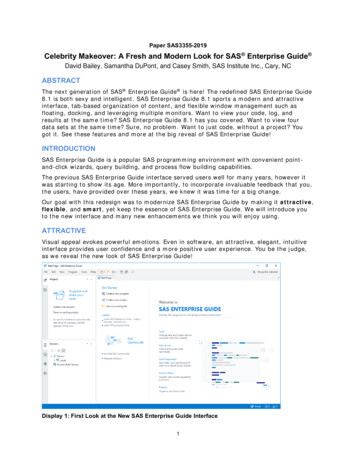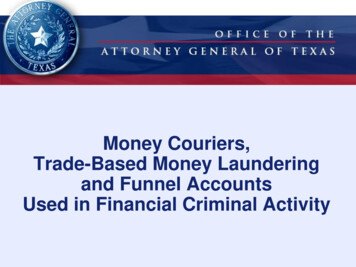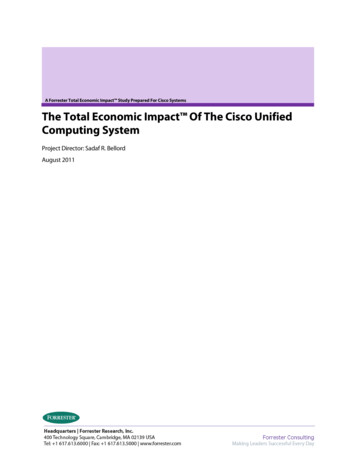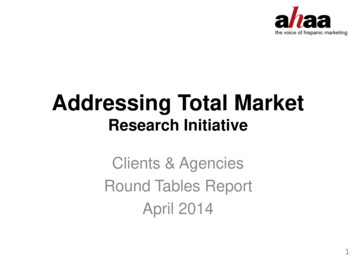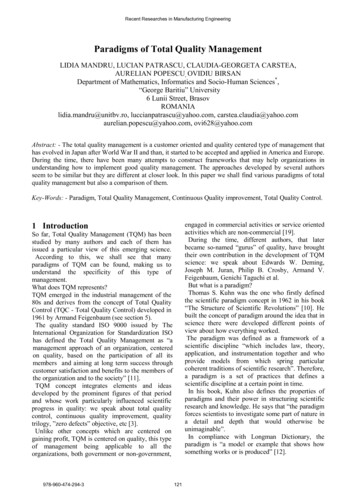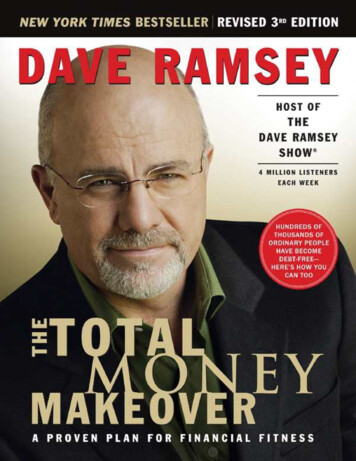
Transcription
TheTOTAL MONEYMAKEOVER
Other Books from Dave RamseyThe Total Money Makeover WorkbookThe Total Money Makeover Spanish Edition(La Transformación Total de su Dinero)Financial Peace RevisitedFinancial Peace PlannerFoundations in Personal Finance(High-school Curriculum)Tranquilidad Financiera(Spanish edition of Financial Peace )More Than EnoughMore Than Enough PlannerLife Lessons with Junior(Children’s Series)
TheTOTAL MONEYMAKEOVERA Proven Plan for Financial FitnessDave Ramsey
2003, 2007, 2009 by Dave RamseyAll rights reserved. No portion of this book may be reproduced, stored in a retrieval system, or transmitted in any form or by any means—electronic, mechanical, photocopy, recording, scanning, or other—except for brief quotations in critical reviews or articles, without theprior written permission of the publisher.Published in Nashville, Tennessee, by Thomas Nelson. Thomas Nelson is a trademark of Thomas Nelson, Inc.Thomas Nelson, Inc. titles may be purchased in bulk for educational, business, fund-raising, or sales promotional use. For information,please e-mail SpecialMarkets@ThomasNelson.com.Scripture quotations noted NKJV are from THE NEW KING JAMES VERSION. 1979, 1980, 1982 by Thomas Nelson, Inc.,Publishers. Used by permission. All rights reserved.Scripture quotations noted CEV are from THE CONTEMPORARY ENGLISH VERSION. 1995 by the American Bible Society.Used by permission.Scripture quotations marked NRSV are from the NEW REVISED STANDARD VERSION of the Bible. 1989 by the Division ofChristian Education of the National Council of the Churches of Christ in the U.S.A. All rights reserved.ISBN 978-1-59555-216-7 (SE)ISBN 978-1-59555-078-1 (2009 edition)Library of Congress Cataloging-in-Publication DataRamsey, Dave.The total money makeover : a proven plan for financial fitness / Dave Ramsey.p. cm.ISBN 978-0-7852-8908-1 (2007 edition)1. Finance, Personal. 2. Debt. I. Title.HG179.R31563 2003332.024'02—dc212003014115Printed in the United States of America09 10 11 12 13 WC 5 4 3 2 1
To my beautiful wife, Sharon, who walked arm in arm with me through a Total Money Makeover—I love you, honey.To the superstars all across America who have had the courage to face the person in the mirror, the culture, their family,and even their coworkers as they “lived like no one else so later they could live like no one else.” You who havecourageously had a Total Money Makeover of the heart and wallet are the real superstars.To the Dave Ramsey team and the Thomas Nelson team for tireless hours on this project to make this material available toeveryone across this great land.
ContentsIntroductionWhat This Book Is NOTFlying Turkeys and Skinny Dipping1. The Total Money Makeover Challenge2. Denial:I’m Not That Out of Shape3. Debt Myths:Debt Is (Not) a Tool4. Money Myths:The (Non) Secrets of the Rich5. Two More Hurdles:Ignorance and Keeping Up with the Joneses6. Save 1,000 Fast:Walk Before You Run7. The Debt Snowball:Lose Weight Fast, Really8. Finish the Emergency Fund:Kick Murphy Out
9. Maximize Retirement Investing:Be Financially Healthy for Life10. College Funding:Make Sure the Kids Are Fit Too11. Pay Off the Home Mortgage:Be Ultrafit12. Build Wealth Like Crazy:Arnold Schwarzedollar, Mr. Universe of Money13. Live Like No One ElseMeet The Winners ofThe Total Money Makeover ChallengeAbout the AuthorBudgeting FormsIndex
IntroductionRead the stories of the lives changed by this book! As a matter of fact, I recommend you skip throughthe book reading all the stories first. They will inspire you to read all the way through and actually dothe Proven Plan to Financial Fitness.Many years ago I was given a calling: to show people the truth about debt and money and to givethem the hope and tools necessary to set themselves free financially. First, I did that with a fewspeaking engagements and a small self-published book titled Financial Peace. Later Financial Peacewas published by a New York publisher and became our first New York Times bestseller. I begandoing a small local radio show that has now grown to more than 450 stations and millions of listenersthat tune in weekly. We started teaching a thirteen-week class called Financial Peace University,which has had over 1 million families attend. Then came The Total Money Makeover.I am positive that personal finance is 80 percent behavior and only 20 percent head knowledge.Our concentration on behavior—realizing that most folks have a good idea of what to do with moneybut not how to do it—has led us to a different view of personal finance. Most financial people makethe mistake of trying to show you the numbers, thinking that you just don’t get the math. I am sure thatthe problem with my money is the guy in my mirror. If he will behave, he can make the money thingwork. The math of wealth building is not rocket science; it is simple—but you have to DO IT!So the proven Total Money Makeover plan I teach has become very successful not because I havefound the secrets of the rich. Not because I had some revelation that no one else has ever had aboutcredit cards. Not because I am the only one with a “Debt Snowball” plan. Instead, this proven plan ishaving a national impact because I have realized that to change your money thing, you have to change.You have to change your life. When you change your life, you will get out of debt, give, and invest atan unbelievable rate. When you read the stories in this book, you will read not about mathematics, ormagic systems, but about changed lives. You will read about transformed marriages and relationships.Because when you change your life, you really change your life.So when Mike Hyatt, the president and CEO of Thomas Nelson Publishers, brought me the conceptfor a Total Money Makeover book, I became very excited. I became excited because I knew this bookwould inspire readers to take immediate action through a simple, step-by-step process that could onlylead to life-changing results. Hope—the light at the end of the tunnel, that is, not an oncoming train—is a very powerful force. The Total Money Makeover has given HOPE to hundreds of thousands offamilies. This book has given them hope to win, and that hope has caused them to take action andclaim ultimate victory over their financial struggles and worries—and to actually win! The number ofpeople that I meet across this nation who tell me this is the first book of any kind they have read in tenyears is staggering. The Total Money Makeover is a book for everyone. It is for high-income earners,as I am. And it is for someone beginning at the bottom, which is where I once was.You are about to read about a process, a proven plan, to win. You will find the plan to be verysimple yet very inspiring. The principles are not mine. I stole them all from God and your
grandmother. The principles are common sense, which isn’t so common anymore. The plan is mine—and I’m no genius—created by simply observing literally millions of lives with whom I haveinteracted through radio, TV, books, classes, the Internet, e-mail, podcasts, and our Live Events. Ihave successfully bottled common sense about money into a plan that anyone can do. And millionsare!A couple of decades ago, when I first started talking about these principles, I knew they had helpedmy wife, Sharon, and me survive going broke and begin to prosper. The first hundred times I spoke onmoney, I wasn’t as confident of the principles as I am now. Nowadays I look into the eyes of agazillion people who have followed this plan and experienced, as we did, excitement, hope, andgratitude. I am so thankful that I have not only given them a proven plan but have also inspired them tochange their family tree.I am so confident in The Total Money Makeover principles and this process that I cannot stand itwhen someone doesn’t get it. Because I am so convinced my plan will work for everyone, myanswers to the same questions will never change. By recognizing and identifying some basic truthsand everyday common sense, I have convinced millions of people to change their lives—to have aTotal Money Makeover. Are you next?
Read thisBEFORE You BuyThe Book!What This Book Is NOTI know it may be hard for you to believe, but I get a lot of hate mail and criticism. This book and whatI have or have not said in it has generated a lot of negativity and name-calling. That is fun. Not funbecause I set out to offend or because I love reading the nasty things people often say. It is funbecause the negativity means two things: One, for some people we are touching a nerve that needs tobe touched in order for them to change their lives, and two, I am actively and passionately pursuingthe truth. (Aristotle once said “To avoid criticism say nothing, do nothing, and be nothing.”) I can’thelp millions of people change their lives by saying nothing, doing nothing, and being nothing. So Itake the anger, the criticism, and even the hate mail as encouragement.My publisher suggested I “answer my critics.” I will pass. My grandmother used to say, “Thoseconvinced against their will are of the same opinion still.” However, I do not want you, dear reader,to be misled. So it is appropriate that I tell you what this book is NOT. That way you can decidewhether or not to spend your hard-earned money on it.This Book Is NOT Sophisticated or ComplicatedIf you are looking for a detailed, in-depth guide to investing, you have not found it. If you are lookingfor boring academic chirping that will put you to sleep using words only to support the author’s ego,you have not found it. What I have discovered is that some of the most profound and life-changingtruths you will ever discover are very simple.In our culture we worship the complicated and the sophisticated. If you know how to work yourDVD player, you may not have a good one. In the financial world we have been taught to be arrogantsnobs. Some believe that simple ideas are not profound, that instead, simple ideas are for the “littlepeople.” That is a false and arrogant notion. I have met with thousands of millionaires, and in almostevery case they keep their investing and money philosophies very uncomplicated. Just this week I wasdiscussing investing and business structure with a friend of mine whose net worth is over twentymillion dollars, and his words to me were, “I always keep it simple and clean.” Only the financialgoobers like to complicate things for the sake of justifying their existence or justifying how much theypaid for their education. Please do not look here for a detailed guide to set up an estate plan or a deeptheory on investing. That is not what I do. What I do is help people understand and act on timehonored truths about money that will truly change your whole life.This Book Is NOT Something That Has Never Been Said
There are many great money authors out there today, and there are even more in our past. Very littlethat you read in this book will be something that someone else has not written or said. We often say onour radio show that we give the same financial advice your grandmother would, only we keep ourteeth in. I suggest you read a lot of different people, as I do. I have invented very little in this area ofmoney. What I have done is packaged the time-honored information into a process that is doable andhas inspired millions of people to act on it. Most of us know what to do; we just have trouble doing it.How do you lose weight? Exercise more and eat less. I know that, and yet I bought and read a coupleof books on the subject while I took action, and I lost thirty pounds. Did the authors of those bookstell me big ideas that were groundbreaking? No, they simply gave me an action plan and somesupporting details to what I already knew had to be done. Welcome to my world.This Book Is NOT Going to Mislead You on Investment ReturnsThere are several ignorant people in our country today on the returns offered by investing well.Ignorance is not lack of intelligence; it is simply “not knowing.” Sadly, many intelligent but ignorantpeople seem to think that making a 12 percent rate of return on your money in a long-term investmentis impossible. And that if I state that there is a 12 percent rate of return available, then I have lied toyou or misled you.I recommend good growth stock-type mutual funds in this book as a long-term investment and dareto state that you should make 12 percent on your money over time. The supporting data for that boldstatement can be found by looking at the historical averages of the S&P 500 index. Widely regardedas the best single gauge of the US equities market, the Standard & Poor’s 500 is an index with 500 ofthe largest companies in leading industries of the US economy. The S&P 500 has averaged 11.67percent per year for the last eighty plus years, as of this writing. This includes the big drop in the2008 market. Most experts and anyone who has had even one finance class agree that the S&P 500 isa great statistical measure of stock market returns. This is such a standard, or bellwether, thatvirtually every stock fund will show you its returns in comparison to the S&P 500.I purchased a Growth and Income Stock Mutual Fund many years ago, that I still invest in, and ithas averaged 12.03 percent per year since 1934 (75 years as of this writing). I bought another lastweek that has averaged over 13.9 percent per year since 1973, as of this writing. And yet anotherwith average annual returns of 12.01 percent since 1984, and another averaging 12.39 percent since1973, and yet another averaging 11.72 percent since 1952. Any decent broker with the heart of ateacher can, in his or her sleep, lead you to funds with long track records averaging over 12 percent.So don’t let anyone tell you that you can’t predict a 12 percent rate when you are consideringinvestments for ten years or longer.This Book Is NOT Written by Someonewith No Academic Credentials
I seldom list my formal academic credentials because, honestly, I don’t think they are important. Ihave met so many broke people with financial credentials that I almost think it discredits me to havehad formal training. Yes, I have a degree in finance. Yes, I have been or am licensed in real estate,insurance, and investments. Yes, I do have many of the stupid letters to put after my name. But thething that qualifies me most to teach about money is that I have done stupid with zeros on the end. Ihave been there, done that. I have a PhD in D-U-M-B. So I know what it is like to be scared andscarred. I know what it is like to have my marriage hanging by a thread because of financial stress. Iknow what it is like to have my hopes and dreams crushed by my own stupid decisions. That qualifiesme uniquely to teach and to love hurting people. The other huge qualifier is that I used the principles Iteach to personally build wealth. My wife and I have truly lived this book. The things we teach arenot theory—they work!But the teaching credential that I am most sure of and which further qualifies me is the hundreds ofthousands of stories of people across America being set free by this book. This stuff simply works.So don’t take financial advice from broke people.This Book Is NOT Politically CorrectI stated earlier that personal finance is 80 percent behavior. To properly view behavior and tounderstand how to change behavior intelligently, we must consider several things. Behaviorintelligently viewed takes into account the emotional, the relational, the family history, thesocioeconomic impacts, and the spiritual. To ignore any of these while discussing behavior changeabout money is incomplete and very naive. So I openly discuss the spiritual in this book. As aChristian, I include some Bible verses. This is not a “Christian” book, and it for sure isn’t a Biblestudy on the subject of money. But this is a book about a “Proven Plan to Financial Fitness” that myteam and I have developed over two decades, and that plan includes addressing the spiritual issuessurrounding money. So I upset both sides—those who don’t like it because I include spiritual thoughtsin my teachings and those who don’t believe my writing is spiritual enough. Either way, you havebeen warned.This Book Is NOT WrongDon’t confuse extreme confidence with arrogance. I am extremely confident that this material works,because millions of people have benefited from it. I am not arrogant because I realize I am notpersonally responsible for any of the lives changed. The stuff I teach is the truth, and those principlesare responsible for changing lives. But I always answer the same questions with the same answerseven though sometimes folks think their situation may be different. It isn’t different. The principlesstand, and they work every time.This Book Is NOT the Same As My Other Books
When we took on The Total Money Makeover project, we had to answer a question of integrity:Could we honestly go into the market and ask my readers to buy another book that said the samething? I couldn’t in good conscience do that. Financial Peace has sold nearly 2 million copies as ofthis writing, so did I really need to write another book? I came to the conclusion that there was adistinct difference in the two projects. Financial Peace is “what to do with money.” It is a greattextbook for commonsense money management. So how is The Total Money Makeover different? It ismore than a “what to do” book—it is a “how to do it” plan. This is a process book. We are aiming atcarefully weaving inspiration and information together into a step-by-step plan. Yes, you will find inthis book a lot of the same subjects along with many of the same principles I discuss in my otherbooks, but this book is different in that it is a process-driven work.If you are looking for a ton of new information because you are someone who only gathers factsand figures, then you will be disappointed. If you are looking to engage this money thing head on, youwill love this book. Many Financial Peace readers have told me that The Total Money Makeovergave legs to the concepts to which they had been introduced, so they were thankful to read it as well.But again, don’t look for some big revelation or chapters of new principles.This Book Is NOT Getting Any Complaints or Criticism . . . . . from people who do it. I have never had someone write me saying, “I got on a budget, got out ofdebt, got on the same page with my spouse, built wealth—and I HATE IT.” For those who havefollowed this plan and discovered a new life of financial freedom, their lives have been changedforever! Wouldn’t you like to experience the same transformation? You can be the next success storypeople hear about. You can have a Total Money Makeover starting today!
Flying Turkeys and Skinny DippingWhen I was a child, my grandmother—a second-grade schoolteacher who also taught drama—used tosit me on her knee and read to me. She read with great enthusiasm and a lot of drama.One of the children’s stories she read to me was about the three little pigs. One built his house outof straw, one out of twigs, and one out of brick. You know the story—the two who built their houses“quick and dirty” goofed off, partied, and made fun of the bricklayer because he was taking too muchtime and effort to do it right. Of course, when the wind and rains came, the two short-term thinkersended up moving in with their brother. Why? Because he had prepared well enough to weather thestorms. The other two found their lives completely blown apart.Economic Storms, Real OnesA huge economic storm hit America—and the rest of the world—in 2008. As with all strong storms,the only houses that survived were the ones that were built well, on a solid foundation. The rest wereblown over. Companies who had been built well survived; those who hadn’t are now history. Manyonce-great businesses abandoned their strong foundations by investing in bad, high-risk investmentsand taking on mountains of debt. Sadly, most of those companies are now history or are owned bysomeone else.What happened? Well, this is not a textbook on economics, so we won’t dissect every detail.However, it is instructive to your Total Money Makeover to look at the event to learn our privatelessons. The 30,000-foot view that you would get from an airplane might look like this:Broke people in serious financial trouble borrowed money from greedy bankers at horrible termsand high interest rates to buy homes. The loans were not prime (good) loans, so they were accuratelycalled SUBprime loans. That just means these mortgages were less than good. Duh.This rip-off lending has always been done, but never on such a large scale. In an effort to makemore profits to keep their stock prices up, banks and investment bankers began to buy these loans inbulk—and they bought lots of them. What was unthinkable in the investment community just a fewyears earlier became common practice.Formerly legitimate, upstanding, major banks and investment bankers essentially became loansharks using very sophisticated financial instruments. For years, the mortgage industry had packagedgood mortgages together and sold them as bonds. You have probably heard of Fannie Mae Bonds.That used to refer to a group of good Fannie Mae mortgages that were wrapped together and sold asunit, or bond. During this period of stupidity, however, the SUBprime (bad) loans were packagedtogether and sold as bonds—a lot of them.
We live in a cause-and-effect world. What you sow, you will reap. In a shocking turn of events, thebroke people didn’t pay their mortgage payments (he says sarcastically). This, for some unknownreason, seemed to surprise the greedy bankers. Surprise! Broke people can’t pay ridiculous housepayments! Go figure.The big problem, however, was scale. A lot of broke people didn’t pay their payments. So,foreclosure numbers began to rise rapidly. In some boom markets, where the real estate prices hadshot up artificially high, the foreclosures began bringing home prices down. And down and down.With values dropping so low, relatively secure and responsible home- owners started to get introuble too. Fear broke out on Wall Street, and stock prices started dropping. By the time the fear gotto Washington, it had become a full-blown panic. And once the panic got to the news media, it hadbecome all-out hysteria.Every day, American consumers watched the hysteria play out on television. With their 401(k) andhome values dropping, they wisely decided this was not a good time to keep spending like a drunkenCongressman.When we stopped buying stuff at a breakneck speed, the economy slowed, and businesses beganhurting everywhere. Companies who were deeply in debt and cash-poor began to die. A LOT ofbusinesses vanished almost overnight. People stopped buying washers and dryers, so the washer-anddryer manufacturer started laying people off, and unemployment rose. This, of course, just made thecycle go around again, forcing real estate and stock prices even lower.Good News, Bad NewsThe good news is that we are recovering and will continue to recover. Some learned the painfullessons on a private, individual level; others learned the economic lessons on a more widespread,national level. Many people didn’t learn anything at all.The great news is that, for some of you, this event was your Great Depression, emotionallyspeaking. The Great Depression permanently changed the way many people handled their money. Ifyou have a grandfather or great-aunt who was an adult during that time, he or she likely has acompletely different way of looking at debt, saving, and giving than most people of other generations.That is because your loved one has experience. And as my pastor says, “a man with an experience isnot at the mercy of a man with an opinion.”I went broke twenty years ago, and that experience changed my life. I have applied the principlesof this book to my life for the past two decades, so when this storm hit in 2008, I was just a spectator.It didn’t hurt me a bit. I have actually come out ahead by buying real estate at great prices andinvesting heavily in the stock market while both were down.I’ve spent the last twenty years trying to get people to live these Total Money Makeover principles.A lot of people have listened, so when the winds blew and the storms came, they were just as ready
as I was. They had a strong foundation.Flying TurkeysWhat does all this mean for your Total Money Makeover? The first lesson of this economic storm isthat your financial process and principles must work in good times and in bad times—otherwise, theydon’t work. Our economy had been so good for so long that really stupid ideas had been working onthe short term. That fooled people into believing that stupid had become smart. In other words, stupidhadn’t been stress tested in quite a while; when it finally was, it came up looking, well, stupid.When times are booming, you can do dumb things with money, get sloppy, and take huge riskswithout realizing it. I have heard it said this way: “Even a turkey can fly in a tornado.” People wererunning around, buying things they couldn’t afford with money they didn’t have, to impress peoplethey didn’t even like; and they were doing it in record numbers. Worse, they seemed to get away withit!They were like the two little pigs with straw and twig homes: As long as the sun was shining, lifewas a party, and the pig with brick seemed kind of nerdy, or overly conservative, or even fanatical.But when their stupid theories were stress tested, their houses fell.Jim Collins, one of America’s greatest business writers, has a book out called How the MightyFall. In this book, he discusses the five stages of decline when a business fails, or falls. There is agreat application here for our nation’s economy and for your life and mine.Collins says the first stage of decline is marked by hubris. Pride and arrogance, mixed with a falsenotion of invincibility, lead the mighty to take huge, ridiculous risks. In our case, that would beborrowing lots of money and not saving any because “my job is ‘stable.’ I can afford the ‘easypayments’ with my ‘job.’”This hubris causes sloppiness and denial of risk. Hey, that sounds like me twenty years ago—rightbefore I went broke. I had been taught a group of myths—lies—that I accepted as truth about money. Ithought the rules of risk and restraint didn’t apply to me because I was so smart. That led me to builda house of cards that fell the first time there was a light breeze, much less a real storm.Here’s the lesson: Just because you see a turkey flying in a tornado doesn’t mean turkeys can fly.Just because some wild-eyed theory of investing, borrowing, and living without cash reserves worksin good times doesn’t mean you can survive a storm. Remember, your ways of handling money have towork in good times and in bad.Skinny-DippingWarren Buffett has a great saying: “When the tide goes out, you can tell who was skinny-dipping.” Ihave taught for years that if you have a bad map, you will be late for—or completely miss—the party.
The principles that you build your life on will determine your level of success. If you plan yourmarriage around a bad map, or bad set of assumptions, then it will likely fail. If you have all the goodintentions in the world, but build your financial house on bad ideas, it will fall. I personallyexperienced this a long time ago. With this last recession, many more Americans are discovering thattheir theories about money and their assumptions about how money works were wrong. And theydiscovered they were wrong the hard way—through pain.Overspending that doesn’t feel like overspending because things are going well is stilloverspending. Using debt to invest in real estate or the stock market and the hope of a quick returnwill cause you to go broke the minute the market turns. Chasing the next get-rich-quick scam, like thelottery, or investing in gold, will always bring you pain. Hiring someone else—like some debtsettlement company—to fix your life virtually never works.The myths—lies spread by our culture—that were covered in this book’s first two editions have allbeen proven by this economic downturn. If you live the way we teach in this book, you will prosperin good times and in bad times.I have a friend that we will call Chris. Chris told me an interesting story in the middle of the latestrecession that illustrates what I am pointing out to you. For thirteen years, Chris worked for a largecorporation whose name you would recognize. He started his Total Money Makeover about sevenyears ago. When I saw him two years ago, he ran up to me with a big smile and big hug to proudlyproclaim that he was “DEBT FREE!!” including his home. He had absolutely no debt, and had saved 38,000 in his emergency fund.When I saw him again a year later, he had another fun story to share with me. It seems that he andhis boss had become best friends over the years that they worked together. That week, his friend—hisboss—came into his office, with blood drained from his face and his lip quivering, saying, “I don’tknow how to tell you this, but corporate is making me lay you off.” Chris jumped up from his chair,ran around the desk, gave his friend a big hug, and said, “Cool! How much is the severance?”The company gave him more than 70,000 in severance, and he is now starting his own business—something he has wanted to do for years. He wasn’t stressed, but instead saw only opportunity,because he was ready. As of this writing, he will make almost double his old salary with his newbusiness this year. Wow.However, most people live on the other side of the coin. When they get news of a layoff, they havethe blood drain from their faces and it is their lips that are quivering. If you have lost your job andare struggling, I am not picking on you. I have seen hard times. But I want you to do what I did when Ifaced pain brought on by my own stupid decisions and lack of preparation. I said very loudly,“NEVER
Ramsey, Dave. The total money makeover : a proven plan for financial fitness / Dave Ramsey. p. cm. ISBN 978-0-7852-8908-1 (2007 edition) 1. Finance, Personal. 2. Debt. I. Title. . The Total Money Makeover has given HOPE to hundreds of thousands of families. This book has given them hope to win, and that hope has caused them to take action and .File Size: 2MB
